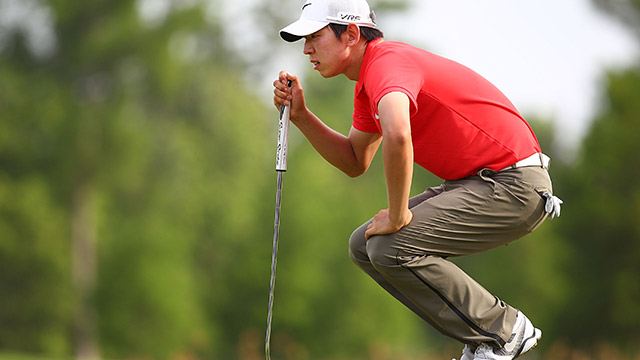NEWS
Putting tips for windy conditions

It was a key moment in the tournament: Seung-Yul Noh, facing a 14-foot par-saving putt on the 17th hole Sunday to keep his lead at three shots. And compounding matters? A gusty, swirling wind that accentuated TPC Louisiana's undulating greens.
Just like he had done all week, Noh calmly and methodically stroked the ball towards the cup, and the ball stayed on an inside left-edge path for a clutch par.
PGA PROFESSIONAL LOCATOR: Find a PGA instructor near you
Here's the highlight:
So faced with a similar situation -- especially since spring weather conditions for golf can sometimes be blustery -- what are some tips amateurs can take from the way Noh took on the wind on Sunday?
It's a matter of building a steady platform that puts your center of gravity as low as possible to combat the effects of the wind pushing against you as you try to make a smooth, even putting stroke, according to PGA professional Jeff Davis, Head Golf Professional of Apple Mountain Resort and Golf Club in Clarkesville, Ga.
INSTRUCTION VIDEOS: More putting tips
Davis said the easiest way to do that is widen your stance slightly and flex your knees more than normal. But there is a trade-off.
"Now, that's going to restrict your motion, so you're going to make a shorter stroke," Davis said. "You're going to get some gusts that will try to throw you off-balance, and that's what you're trying to guard against."
What you're trying to do is place your weight right over your shoelaces, according to Davis.
"Generally speaking, you want to build yourself a more solid base than what you'd normally have on a regular day, "Davis said. "The hard thing is that your stroke, going back, is affected by the wind. And the roll of the ball will be affected by the wind."
SWING PLANE: Learn more to make consistent contact
If you know you're going to face a day with gusty or swirling winds, make sure you take that into consideration when you get out on the putting green. Downwind putts, especially downhill and following the grain, will have more speed than normal. The opposite is true for putts into the wind and against the grain, Davis said.
"The greens themselves, if you look at your putt and the grass is shiny, you're following the grain," Davis said. "If it's not shiny, you're into the grain, which will slow the ball more and make you more susceptible to the wind. The way greens are now, if you have a putt of any length, you'll see some shiny and some dark throughout, so you have to allow for that.
"When you're putting into the grain where it's dark, the ball's more likely to bounce and get more effect from the wind."
HIT IT FARTHER: Add flexibility and rotation to your body turn
One more thing: Unless it's raining or very humid, wind will cause the greens to dry out more quickly than normal. That also will affect the speed and break of your putts, so take that into consideration when you step up to hit.
In any case, be aware that wind can affect the roll of your ball, just as it can affect the spin and flight on longer shots. With these tips, you'll be better prepared for any conditions Mother Nature can throw at you.
